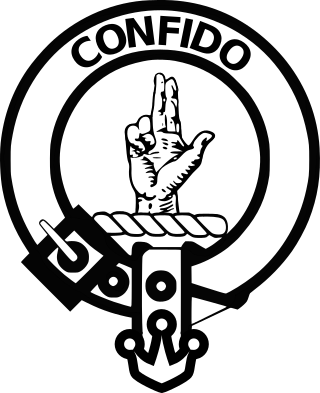Related Research Articles
James Hamilton, 1st Earl of AbercornPC (S) (1575–1618) was a Scottish diplomat for James VI and an undertaker in the Plantation of Ulster, Ireland.
John Stewart, 4th Earl of Atholl, called the Fair, was a Scottish nobleman and courtier. He was favoured by Mary, Queen of Scots, but later turned against her.
The Peerage of the United Kingdom is one of the five Peerages in the United Kingdom. It comprises most peerages created in the United Kingdom of Great Britain and Ireland after the Acts of Union in 1801, when it replaced the Peerage of Great Britain. New peers continued to be created in the Peerage of Ireland until 1898.

Baron Kilmarnock, of Kilmarnock in the County of Ayr, Scotland, is a title in the Peerage of the United Kingdom. It was created in 1831 for William Hay, 18th Earl of Erroll. This was a revival of the Kilmarnock title held by his great-grandfather William Boyd, 4th Earl of Kilmarnock, who was attainted in 1746. The barony of Kilmarnock remained a subsidiary title of the earldom of Erroll until the death in 1941 of the eighteenth Earl's great-great-grandson, the twenty-second Earl. The earldom, which could be passed on through female lines, was inherited by the late Earl's daughter and only child, the twenty-third Countess. The barony of Kilmarnock, which could only be passed on to male heirs, was inherited by the Earl's younger brother, the sixth Baron. He assumed the surname of Boyd in lieu of Hay the same year he succeeded to the title. As of 2013 the title is held by his younger son, the eighth Baron, who succeeded his elder brother in 2009.
William, Willie, Will or Bill Boyd may refer to:
Colin Campbell, 6th Earl of Argyll was a Scottish nobleman and politician. He was appointed to the Lord Chancellorship of Scotland.

The Lords of the Congregation, originally styling themselves the Faithful, were a group of Protestant Scottish nobles who in the mid-16th century favoured a reformation of the Catholic church according to Protestant principles and a Scottish-English alliance.

Earl of Kilmarnock was a title created twice in the Peerage of Scotland for the Boyd family. It was first created in 1454 for Robert Boyd, Great Chamberlain of Scotland. It was created a second time in 1661 for William Boyd, 10th Lord Boyd. Both titles were forfeited in 1746.

James Lowther, 1st Earl of Lonsdale was an English country landowner and politician who sat in the House of Commons for 27 years from 1757 to 1784, when he was raised to the Peerage of Great Britain as Earl of Lonsdale.
William Ruthven, 1st Earl of Gowrie, 4th Lord of Ruthven was a Scottish peer known for devising the Raid of Ruthven.

Claud Hamilton, 1st Lord Paisley was a Scottish nobleman who fought at the Battle of Langside in 1568 for Mary, Queen of Scots. He is the ancestor of the earls, marquesses and dukes of Abercorn.

Clan Boyd is a Scottish clan of the Scottish Lowlands and is recognized as such by the Lord Lyon King of Arms.
James Hamilton, 2nd Earl of Abercorn was a Catholic Scottish nobleman. He, his wife, his mother, and most of his family were persecuted by the kirk as recusants. Implementing his father's will, he gave his Irish title of Baron Hamilton of Strabane to his younger brother Claud. His younger brothers inherited his father's Irish lands, while he received the Scottish ones, which he squandered away, being deep in debt in his later days.
Claud Hamilton, 2nd Baron Hamilton of Strabane was the founder of the Strabane branch of the Hamiltons. He died relatively young at about 32 and his wife, Jean Gordon, married Sir Phelim O'Neill, one of the leaders of the 1641 rebellion, after his death.
David Kennedy, 3rd Lord Kennedy and 1st Earl of Cassilis was a Scottish peer, the son of John Kennedy, 2nd Lord Kennedy. He was born about 1463, in Maybole, Ayrshire, Scotland. He was a Privy Councillor of King James IV and was created Earl of Cassilis by him in 1502. Killed at the Battle of Flodden, on 9 September 1513.
Holders of the office of Lord Chamberlain of Scotland are known from about 1124. It was ranked by King Malcolm as the third great Officer of State, called Camerarius Domini Regis, and had a salary of £200 per annum allotted to him. He anciently collected the revenues of the Crown, at least before Scotland had a Treasurer, of which office there is no vestige until the restoration of King James I when he disbursed the money necessary for the maintenance of the King's Household.
Alexander Boyd, 3rd Lord Boyd was a Scottish noble.
Thomas Boyd, 6th Lord Boyd (c. 1547–1611) was a Scottish noble and politician.

John Lindsay, 17th Earl of Crawford, 1st Earl of Lindsay was a Scottish nobleman.
References
- 1 2 Chisholm, Hugh, ed. (1911). . Encyclopædia Britannica . Vol. 4 (11th ed.). Cambridge University Press. p. 354.